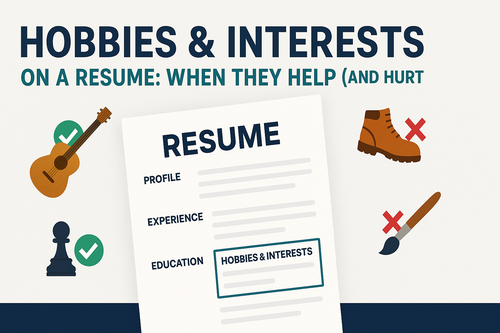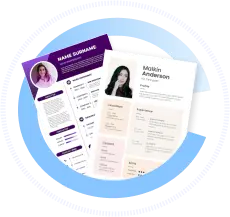Hobbies & Interests on a Resume: When They Help (and Hurt)
Including hobbies and interests on a resume can be a double-edged sword. When chosen wisely, they showcase personality, culture fit, and soft skills, particularly for creative or people-facing roles. However, irrelevant or controversial hobbies may distract or disqualify you, especially in 2025 ATS and recruiter screens.
| What to Do (Short Checklist) |
|---|
| Include hobbies that complement job skills |
| Highlight interests showing teamwork, leadership, or creativity |
| Avoid overly generic or divisive hobbies |
| Tailor hobbies section to company culture |
| Format simply for ATS readability |
Who This Guide Is For
This guide is designed for applicants across all experience levels, especially those applying to creative, customer service, sales, or culture-driven organizations. It’s relevant to beginners and seasoned professionals wanting to add personality while maintaining ATS compliance.
Hobbies & Interests on a Resume — Definition & Purpose
Hobbies and interests are non-professional activities listed to provide insight into your character, reliability, interpersonal skills, and cultural fit. They complement your qualifications and can make you memorable to hiring managers.
Best-Practice Rules (Do / Don’t)
| Do | Don’t |
|---|---|
| List hobbies that demonstrate relevant soft skills | Include polarizing or political activities |
| Connect hobbies to professional traits (leadership, creativity) | Use clichés like “reading” or “traveling” without context |
| Keep the section brief and relevant | Overemphasize hobbies over core qualifications |
| Tailor hobbies to company values and role type | Include hobbies that may appear unprofessional |
| Avoid complex formatting or graphics | Add hobbies just to fill space |
Examples by Level & Industry
Creative Roles
- Photography and digital art, with a focus on Adobe Creative Suite
- Freelance blogging on design trends and user experience
People-Facing Roles
- Volunteer team coach for local youth sports league
- Event organizing and public speaking in community groups
Technical & Corporate
- Open-source software contributor
- Marathon running demonstrating discipline and perseverance
How to Customize Hobbies to a Job Description
- Research company culture and values.
- Choose hobbies that relate to desired soft skills (teamwork, initiative).
- Avoid hobbies irrelevant or contradictory to job environment.
- Tailor descriptions subtly to reinforce professional brand.
- Do not list hobbies if space is limited or if they add no value.
Formatting Tips (ATS + Readability)
- Use a simple heading like “Hobbies & Interests” or “Interests.”
- List hobbies in a comma-separated or bulleted format.
- Keep this section short—3 to 6 items maximum.
- Avoid graphics, icons, or elaborate layouts.
- Ensure ATS scanners can easily parse the text.
Checklist & Templates
| Hobbies Section Checklist |
|---|
| Are hobbies relevant and complementary to the job? |
| Is the section concise and easy to scan? |
| Are hobbies described to show positive traits? |
| Is formatting simple and ATS-compatible? |
| Have polarizing or controversial hobbies been omitted? |
Fill-in-the-Blank Template:
“[Hobby or interest] demonstrating [soft skill or characteristic relevant to role].”
Example:
“Community volunteering showcasing leadership and teamwork.”
FAQ
Q: Should I include hobbies on every resume?
A: Not always. Use discretion based on role, industry, and available space.
Q: Can hobbies improve ATS scores?
A: Rarely; they mostly influence recruiter impressions rather than ATS rankings.
Q: What hobbies are best for creative jobs?
A: Artistic activities, writing, design, social media content creation, and similar.
Q: Are controversial hobbies risky?
A: Yes, to maintain professionalism, avoid sensitive or divisive interests.


